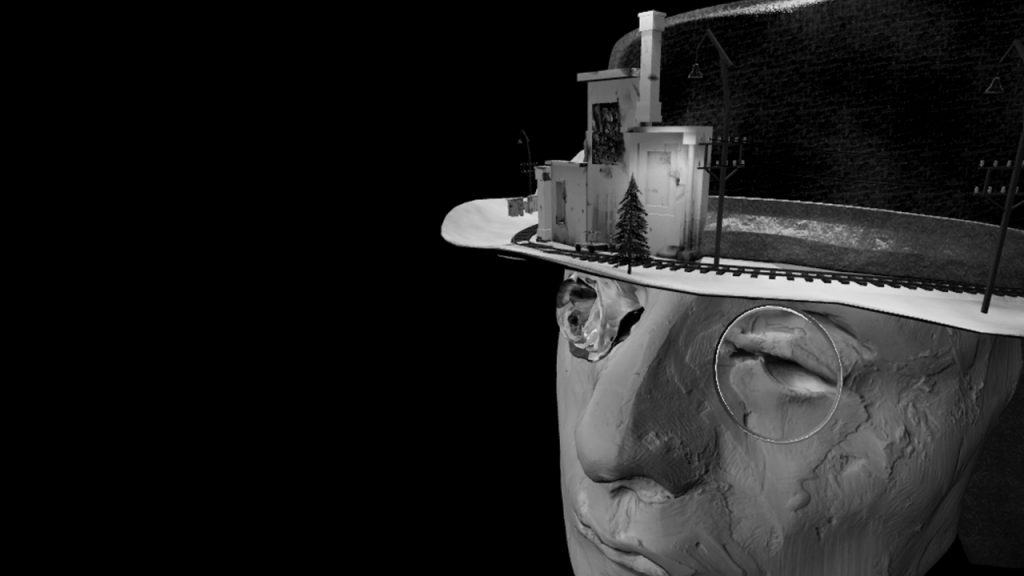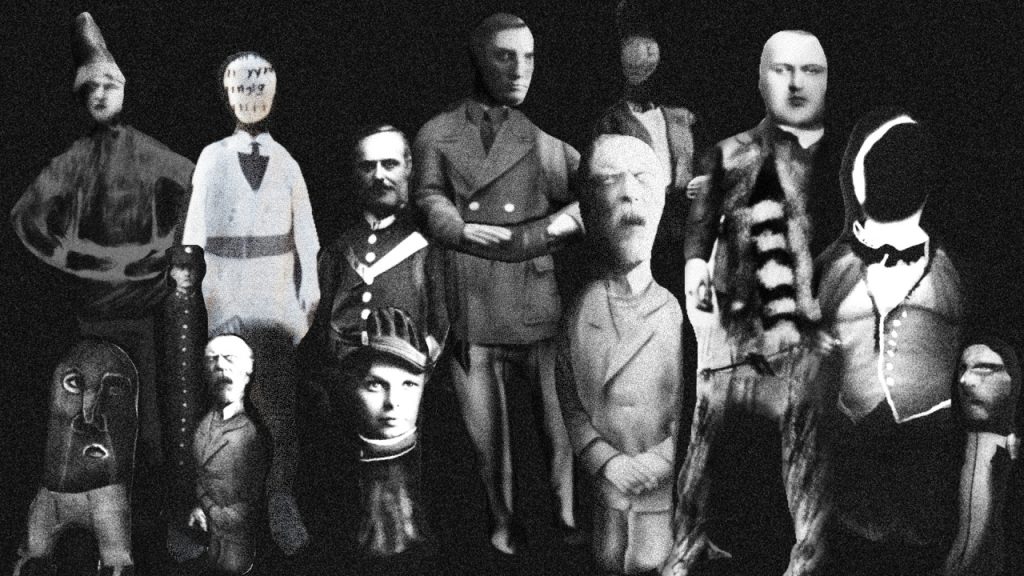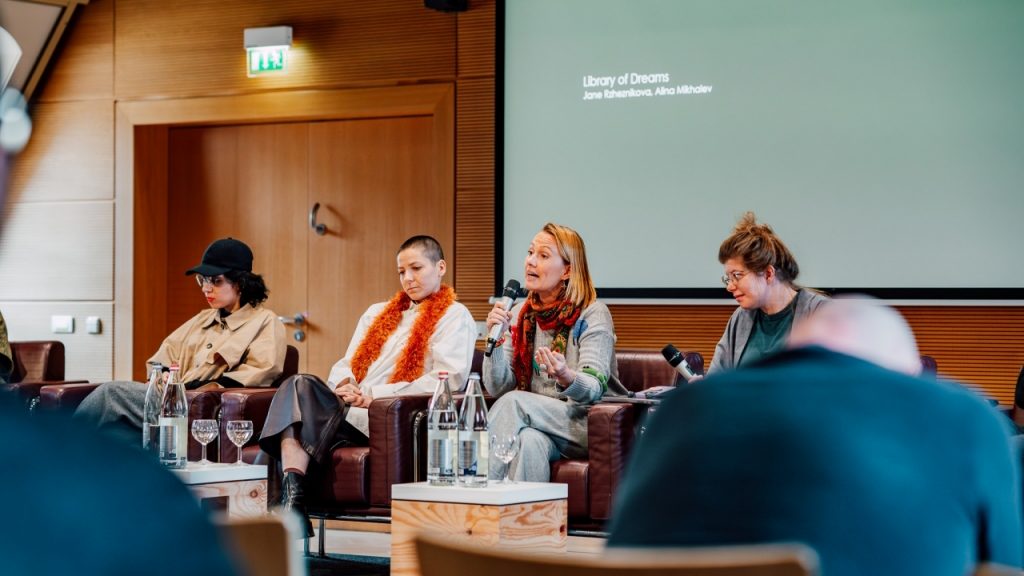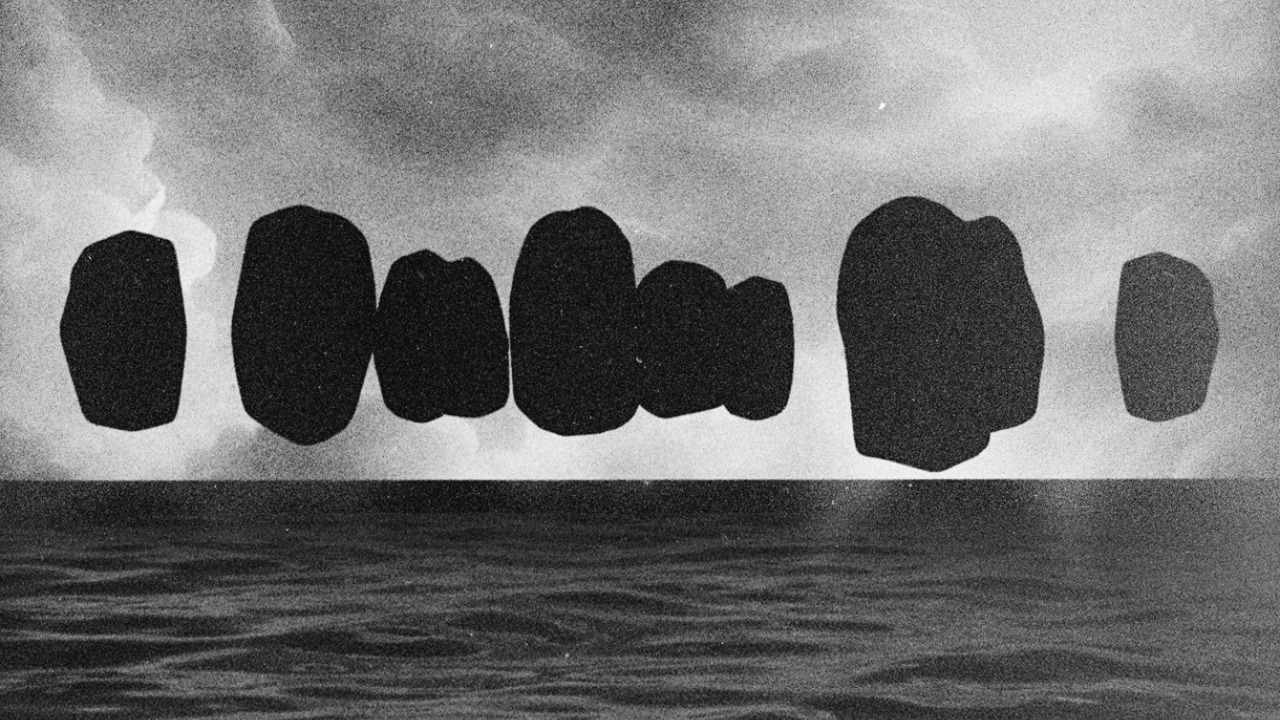Following the world of immersive workshops closely, one of the projects that has recently caught our attention is LIBRARY OF DREAMS created by Jane Rzheznikova and produced by Alina Mikhaleva Savelyeva.
We interviewed Jane and Alina to find out more about this fascinating work in development, which has gone through some very important production stages, from the Digital Autumn: Educational Course to the presentation of an initial prototype at the Sunny Side of the Doc, to the passage through labs such as those of the EUCL and the Biennale College, and now heading to the NewImages Festival.
A work of historical as well as psychological and social research on dreams in the context of war and political repression, which combines a concrete and original artistic vision with a new approach to immersive technology.
Here is what the two artists told us.
Looking beyond: LIBRARY OF DREAMS as a reflection on our hidden emotional universe
JANE RZHEZNIKOVA – LIBRARY OF DREAMS stemmed from a dream I had after Russia invaded Ukraine. I started asking myself questions about it and talking to some friends to find out what dreams they were having. It was then that I realized for the first time how all our dreams had changed after February 24.
I decided to delve into the subject and I did it by looking at some groups on social media where people were describing their dreams – not political ones, because in Russia we hardly talk about politics out loud, but common dreams that still revealed a lot about their changed moods. There were so many nightmares! And I said to myself, ‘These people carry all these feelings inside, they don’t talk about them, they live them silently, but they still exist’. In a way it was a gateway to the universe of real feelings that people experience but do not share.
As I delved deeper, I discovered that there is a lot of research on this subject and most of it regards the Nazi Germany and the Soviet Union. One element that has been and is specifically studied is the so-called political dream. The first person to use this expression was Charlotte Beradt, who wrote a book entitled The Third Reich of Dreams, in which she collected only dreams of a political nature. And then we have the Russian-speaking researcher Irina Paperno, who now works at Stanford, who wrote the book Stories of the Soviet Experience: Memoirs, Diaries, Dreams. Another very interesting reading.
For my personal research I moved in these two directions: on the one hand I looked at the aforementioned groups in social media today; on the other hand, at archives and historical diaries. The idea was to create a connected universe between these different times, because there are a lot of people who went and are going through this and there are a lot of connections between their dreams, and also between the places that people visit in them.

So I developed the idea of an island of dreams, a kind of subspace that would house these oneiric universes.
The project as a whole, anyway, is about empathy and how we can understand each other. I believe that dreams are something very intimate, something that could allow those who live in a free, democratic society like ours to understand what it means to be part of an autocratic or utilitarian regime.
ALINA MIKHALEVA – Certain situations exert pressure on people’s psyches and dreams can give us the opportunity to recognize this and recognize what they conceal. They allow us to understand and reflect on what is really happening “down there”. And the better we understand the situation, the better we understand how to deal with it and how to talk to these people.
LIBRARY OF DREAMS: a work of research and reconstruction
J. R. – When we started working on the research, we were able to collect hundreds of dreams. But then we recognised that if we wanted the experience to work in VR, we had to be more concrete and tell a story. I think that was the tricky part: figuring out which dreams to use and how to use them to create a narrative.
What’s the right dream for this part or that part? How can we compose them together? When you write a story using only your imagination you do a certain kind of work. But when you develop it from a more documentary type of source, you have a completely different task in front of you. And, I think, it was an extremely interesting process to face.

Among other things, we also had to do a lot of dream reconstructions. Very often the descriptions of dreams are vague (‘I was in a room’, ‘there were people watching me’, etc.). We had to understand more precisely the type of locations visualized by people: we could use their personal background to imagine the room they were in, based on the economic category that person belonged to in order to understand what furniture could reasonably be there and this is how we operated in many cases.
Therefore, from this point of view, not only our research looked at dreams. It also considered the environment, the imagined physical spaces people are visiting while sleeping.
A journey through creative workshops
A. M. – I’ve been in the VR industry for quite some time, I started working in 360 production in 2015 and since the pandemic broke out I’ve been very actively involved in social VR and remote events of all kinds.
When the war started in February 2022, I was in Moscow. My family is half Russian/half Ukrainian, so I had no choice but to leave the country and start my life elsewhere. The immersive space can give opportunities to people like me, people who are displaced, who are changing their country, who are building a new life… especially those working in the arts. And at that moment I had a kind of epiphany: I realized that I had something to offer to the communities affected by this situation. So I partnered with the French Institute, proposing an educational programme for digital artists who wanted to transition to XR.
In many ways, Jane herself was an inspiration for this project. We got in touch through friends and at the time she was looking for someone to talk to about VR. The questions she asked me were the same questions that many people ask when they first approach our industry, like where to find specific narrative experiences on immersive platforms. That’s when I realized that instead of giving all this background to one single artist, I could create a programme that could involve several people at the same time.
So, in October 2022, we at Less Media Group started an intensive 10-day course, where we were constantly traveling through virtual worlds, visiting exhibitions, participating in immersive theater experiences, recommending works to see, etc. Then, in the end, the participants had the opportunity to present their projects in VR to the public at a virtual event. Jane was one of them and she presented the idea behind LIBRARY OF DREAMS.
I later found out that after the workshop was over, Jane actively continued working on the project, finding a team and developing the idea further. It was then that I started to collaborate with them and actively participate in various workshops.
The first was Sunny Side of the Doc, where we presented a first prototype. Then came the European Creators Lab, which was fantastic and helped us a lot. We are all based in different countries and to have the opportunity to sit in the same place all together, discuss the very articulate narrative structure of LIBRARY OF DREAMS, delve into the subject matter was an invaluable opportunity. We then moved on to the EUCL prototyping lab, followed by the Biennale College, which we finished a few weeks ago.
I would say that we are satisfied with the progress the project has made over the past year! (laughs)
On the European Creators’ Lab experience
J. R. – The EUCL was an extremely useful experience for us. Before EUCL, we had almost 30 locations for LIBRARY OF DREAMS and an extremely complicated structure, with a lot of visual elements that we could not use in any way, and no clear direction. It is to our mentor in the European Creative Lab, Darren Emerson, that we owe one of the biggest thanks. He adopted a very structured and clear approach with us, which, through very simple questions (e.g. the length of the work), allowed us to better define a pipeline and how to concretely work on an immersive piece… something I had never done before!
So for me the workshop was absolutely fantastic: not only to create the structure of LIBRARY OF DREAMS, but also to understand the process better and identify the elements worth of my time as a creator and the ones that weren’t.
A. M. – Last year I attended the EUCL lab in Lyon. I was very impressed with their approach and how useful it was for me to get out of my daily routine of working in VR and get inspired again.
I was also very pleased with the quality of the lab, its organization and especially the spirit that Astrid Kahmke and Mads Damsbo are creating at EUCL. So, after Lyon, I already knew I wanted LIBRARY OF DREAMS to be at their immersive residency in September.
One of the merits of this residency that I already mentioned is that it gave us the time to stop and really focus for a week on the narrative structure of our work. We took the hundreds of dreams we had collected and selected those that were most meaningful to us… Dreams from different places, dreams from different times to break the linear perspective but even more so the temporal displacement.
We wanted to give the impression that everything was happening simultaneously, beyond the external circumstances, which are in themselves not so relevant in our case. Because when external situations weigh on the soul to the point that we try to suppress them, our fears begin to manifest themselves in a more unconscious, dreamlike way, beyond the specific situation that causes the pressure itself. This is how the human psyche works and what we wanted to grasp in its depths.
From idea to creation through the prototyping process
J. R. – The Leipzig Prototyping lab by EUCL, which I attended with our developer Dinara Kagirova, was incredibly stimulating. In four days we had to create several scenes – a challenging work supported by really brilliant mentors. We were able to reflect on some ideas, realise some did not work and come up with new solutions.
Having a working prototype actually allowed us to understand all this. One of the things that became clear to us, for example, was that the avatars of Meta Humans or ready-made presets didn’t fit the style of representation we wanted to pursue.We identified the kind of realism we wanted to achieve and we practically moved in that direction. Our characters are now all created in clay and then textured! We literally do everything with our hands!
A. M. – This is an aspect of Jane’s work that really needs to be highlighted. Take the images available on the LIBRARY OF DREAMS website: they are all visions that Jane brought to the project very early on. The use of analogue cameras and film cameras to bring these images out of VR is very interesting, in my opinion. You are basically creating and recording the scenes in a very authentic way: our eye is used to this form of media from the past, so what you perceive is that this dreamlike universe has always existed, has always been there for you to discover.
J. R. – We also want the viewers to feel comfortable, as if they are seeing something that happened many years ago, and now it is just history. We want them to feel interest in the work, but at the same time perceive a certain distance between themselves and what they see. And I think the most effective thing in bringing this perspective to life was the choice to start the piece by placing the user at a very large distance and then get so close to the scene that they become the dreamer, but lose their agency at that moment.
A. M. – The clay sculptures mentioned by Jane are also very important for the overall impact the work can have on the user. They represent our characters and we show them immediately, at the beginning of the experience. We present them in a kind of onboarding moment before embodying them in the story and they are all modeled in a very specific way.

J. R. – We wanted to show these characters, but not reconstruct their exact faces. We are not interested in these people appearing precisely as they were in their lives. Also, their portraits are decorated with elements from their dreams. Thus, when these figures appear, we not only present them, but suggest what their dreams are, which users can then recognise in the course of the work.
A. M. – The final effect is really different from what we’re used to and I love the contribution that Jane’s artistic craftsmanship, combined with digital, is making to the artistic style of the project.
J. R. – In this regard, the style of the project has actually changed a lot over time! At some point we realized that it was not so important that people understood the structure. We needed people to understand the feelings! So we made many attempts. We used AI for texturing, because sometimes we need buildings and people to look a bit strange. But at the same time we tried to be very concrete because practically nobody dreams abstract dreams. Nobody envisions flying cubes nor anything like that!

What we needed was to create a mix between very concrete objects and mechanics that were a bit more blurred. We created many dream-inspired mechanics! To mention one, we change the scene behind the user when they turn around, even if they’re still in the same room. The space is very concrete, with a lot of detail, but at the same time it changes a lot and does it in strange ways. All this really helped us convey the experience of dreaming.
Discovering the Biennale College
A. M. – It was very interesting for me to return to the Biennale College. I had already participated as a tutor in 2021, during the pandemic. That year we had operated entirely remotely in social VR environments. Certainly a different experience from the one we had this year!
The College definitely has a very strong and noteworthy programme. The space that is created for participants, by mentors and tutors, is very open and fruitful and allows you to fully immerse yourself in your project, looking at it from every single perspective. For us, it was the moment when we started to go beyond the general structure. We received a lot of very practical, sometimes challenging questions that we had to find answers to.

A great strength of the EUCL labs, though, is that they allowed us to solidify the narrative structure to such an extent that we did not feel the need to change it during the Biennale experience. Even in the discussions with the various mentors in the College and in the constant challenges they posed to us, this aspect remained very solid.
Questions about agency and on how users can move according to it were the most significant in the Venetian context. They were fundamental to the project as a whole, because, once again, they allowed us to narrow the field and focus only on what was really fundamental to the overall work.
J. R. – For me too the most interesting reflections were those around the concept of agency and interactions. But also those about sound: if you think about sound for a scene, you have to ask yourself ‘will it be immersive? Is it going to be narrative?”. You need to understand how it will work, how it will help you convey the feelings you want the user to feel. …We actually had a list of feelings each scene would evoke and we found ourselves playing a lot with contrasting images/music to achieve the most appropriate emotional effects.
A. M. – I need to mention that when it comes to production, sound is a completely different part of the journey. In Venice we found ourselves often discussing how sound is as important as images. And it is precisely the sound, the music, that opens up enormous possibilities for experimentation in our project. Certainly it also implies a greater effort to generate excellent sound design in the 3D space.
Future steps for the development of LIBRARY OF DREAMS
A. M. – The College has recently ended and now of course we are trying to continue the development of the project from the working prototypes we have.
There is still a big production pipeline to follow through. We are now entering the phase of actively looking for partners and possibly co-production opportunities. We are not putting the project on stand-by waiting for funding, mind you, but funding would certainly speed up the development process.
That is why we are planning to talk to several partners who might be interested in supporting the project. Of course, it is a bit challenging for us because of the nature of XR funding in general. In fact, we are not tied to specific countries and normally, in a project like ours, the first funding comes from the National Film Fund or the National Foundation, and then you build co-productions based on that. In our case this is not possible to achieve so we will have to be a bit more creative in looking for partners and producers aligned with our vision.
This is why we will be at the NewImages for the XR Development Market, where we can now have very practical conversations about the production budget, since we already have a very precise vision of the work, the XR space, etc. France is definitely one of the countries we look at. After all I would not have been able to start the educational lab without the support of the French Institute and I am very grateful to them, who continue to support us as much as they can.
Then in September we will be in Venice for the Venice Production Bridge because as a Biennale College project we can automatically take part in the market.
So I am very confident. I believe that between the end of this year and the beginning of next year we will be able to complete the work. Fingers crossed!
Visit director Jane Rzheznikova’s website to find out more about LIBRARY OF DREAMS and the artistic and research work done so far.
Discover more about the EUCL lab in our interview to Mads Damsbo and keep following us for upcoming articles on NewImages and Biennale College.



Leave a Reply
You must be logged in to post a comment.